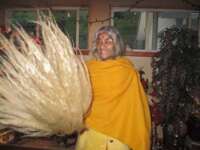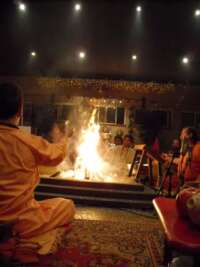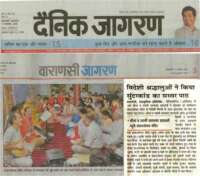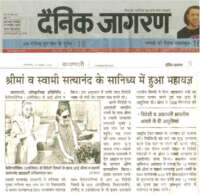~~OM~~
Nothing can quite prepare you for what awaits you at the Devi Mandir. The books I had studied, whose words tended to float around in my head every day of my life, dropped away soon after my arrival. I found my well-enforced personality defences unexpectedly disappearing and I turned into a stuttering child, suddenly unsure of herself. But through all my nervous stumblings and wordy questions, compassionate encouragement underlay everything.
Coming to the Devi Mandir is an odd mixture of coming home and meeting a famous celebrity. The overwhelming beauty and intensity of the temple and the ashram grounds only hints at the amazingly loving beings who reside there. Anyone who has watched Swamiji on the webcam will immediately recognize Swamiji’s seat and the homa fire. Shree Maa’s lyrical voice seemed instantly familiar and comforting.
I met Swamiji just before my first arati. Sitting in front of the homa fire, Swamiji seemed precisely in his element, comfortably and confidently chanting words from ancient texts as though they were coming from his own heart. Even though I was very nervous to finally meet him, Swamiji had absolutely no hint of pretension or self-importance and I was put immediately at ease.
Every word that comes out of Swamiji’s mouth seems to come straight from his soul and his deep eyes sparkle as he speaks (a characteristic that simply can’t be picked up by the ever-present temple webcam). He offered his time and unending knowledge freely and answered all my questions, including some that hadn’t yet escaped the confines of my mind. Swamiji has an abundance of knowledge, both ancient and modern, which he weaves together into very personal advice and enthusiastic teachings.
If Swamiji hadn’t become a sadhu, he could have made a very prosperous living as a computer nerd. His office is immediate evidence of the hard work he puts into the extended Mandir family who tunes in via webcam and internet from around the world. He has used his brilliant mind to learn how to offer his ancient knowledge to the modern citizen of the world. The shreemaa.org website is overflowing with information and teachings freely offered to whomever will take the time to learn. The seriousness of the knowledge he embodies in no way restricts him from being a buoyant and passionate guide and lover of Divine Mother. Throughout the entire day, Swamiji’s words are full of wisdom and humour. He never failed to produce one-liners and word plays when the opportunities presented themselves.
I met Shree Maa the following evening. She has a beauty and softness that is immediately perceivable and as I knelt down to touch her feet with respect, she jokingly commented that I actually knew the proper way to make a greeting. Shree Maa is not of this world and this is immediately seen on her blissful face and light, thin body that seems to float more than walk.
The temple always smells like smoke and fire from the constantly burning homa fire, but when Shree Maa is there, a sweet, ethereal scent of incense fills the room, no matter how smoky it gets. Shree Maa evokes feelings of love with her motherly presence but also with her childlike bliss and innocence. Although she is a regal figure, her playful side is just as prominent. She always asks how you’re doing with a smile on her face and then sneaks in a joke or two. She is also an extraordinary cook, singer, decorator and seamstress, among her many talents.
But Shree Maa and Swamiji aren’t the only family members living at the Devi Mandir. There is a small group of permanent residents and extended family from the area who work together to make the Devi Mandir what it is. The ashram is surprisingly busy and everyone belonging to the Devi Mandir family works hard to improve the grounds and to take care of the family. Each day, nutritious, delicious meals are produced in the kitchen and major projects, including gardens, construction and the arrival of power lines, around the grounds are worked on.
But there are less obvious offerings of service pervading the ashram. The temple is kept meticulously clean and more often than not, singing and chanting drift through the air throughout the ashram. Each person I met offered unlimited kindness and patience with me and I brought home special words from each of them.
My heart called me to the Devi Mandir but Divine Mother and Her family actually got me there and took care of me. It is a beautiful place filled with beautiful people and I am forever changed for having visited. Shree Maa and Swamiji selflessly offer everything they have to whomever will accept and the world is so blessed by their gifts. Although I had a sneaking suspicion that they knew better than I just what it was I needed.



